Understanding the Risk of Firearm Violence in the Houston Area

Table of Contents
Author(s)
Ned Levine
Nonresident Fellow, Baker Institute; Director, Ned Levine and Associates, Houston, TXCary Cain
Assistant Professor, Department of Pediatrics, Division of Public Health Pediatrics, Baylor College of MedicineLisa Pompeii
Director of Research in Patient Services, Cincinnati Children’s HospitalAbiodun Oluyomi
Assistant Professor, Section of Epidemiology and Population Sciences, Department of Medicine, Baylor College of MedicineBindi Naik-Mathuria
Former Nonresident Fellow in Firearm Injury Prevention and SafetyShare this Publication
- Print This Publication
- Cite This Publication Copy Citation
Ned Levine, Bindi Naik-Mathuria, Cary Cain, Lisa Pompeii, and Abiodun Oluyomi, "Understanding the Risk of Firearm Violence in the Houston Area" (Houston: Rice University’s Baker Institute for Public Policy, May 30, 2023), https://doi.org/10.25613/y8gs-7a29.
Tags
Although the media tends to focus on homicides when it comes to firearm violence, and mass shootings in particular, the reality of the public health crisis is more complicated and widespread than many realize. Gun killings are of course tragic, but nonfatal firearm violence can also severely injure victims, leaving them physically debilitated or psychologically damaged for years on end. The family and friends of the victims are often left traumatized as well. But the risks from firearms are even more extensive, involving the psychological costs, since the vast majority of firearm crimes do not involve deaths or injuries.
In the greater Houston area, firearm violence presents various dangers for the public. This report illustrates the scope of the problem by examining firearm incidents occurring in Harris County, Texas, between 2018 and 2021. The incidents were identified using the databases of the four largest law enforcement jurisdictions in Harris County — the Houston, Pasadena, and Baytown police departments and the Harris County Sheriff’s Office — and cover the vast majority of incidents in the county. From this data, we were able to identify trends in the region’s homicide rates, the distribution of firearm incidents by severity, and firearm incident “hot spots”. Ultimately, the findings emphasize the need for a comprehensive approach for reducing gun violence in our society.
Tracking Homicides
The media often focuses on rare incidents involving multiple homicides such as school, mall, or post office shootings, since they are most deadly. Even rarer are serial killers, who usually garner substantial public attention, too. However, the vast majority of homicides have low or no visibility in the media. For example, from 2014 through 2020, there were 2,696 deaths from mass shootings — usually defined as four or more persons being shot aside from the shooter (Gun Violence Archive 2023) — in the United States. In comparison, 106,501 total deaths resulted from shootings involving murder, justifiable homicide, manslaughter, or other accidents. This excludes shooting deaths from suicide, which are considerable (more than 160,000 over the same period). During that time frame, deaths from mass shootings represented 2.5% of all interpersonal shooting deaths while 97.5% were from non-mass shooting killings.
To understand this, look at how homicide data are collected. In the U.S., there are three sources of information on homicide deaths: the FBI, the National Center for Health Statistics, and the Centers for Disease Control and Prevention (CDC) (Fowler et al. 2021; BJS 2014). The FBI gathers reports from police and other law enforcement agencies and lists both incidents and victims through its newly adopted National Incident-Based Reporting System (NIBRS), which provides much more detail than its older Uniform Crime Reporting System (UCR). Although data reporting is voluntary, the vast majority of cities, especially large ones, participate.
The counts from the National Center for Health Statistics, which utilizes the National Vital Statistics System (NVSS), come from death certificates, while the CDC’s National Violent Death Reporting System (NVDRS) combines information from death certificates and reports from medical examiners and law enforcement. The NVDRS is newer and is a surveillance system, rather than a documentation system. The FBI and NVSS generally track each other as well with the NVSS producing slightly higher estimates of homicide due to its inclusion of justifiable homicides and negligent (i.e., accidental) manslaughter deaths, which the FBI does not include (BJS 2014). Most police departments — including those in the Houston metropolitan region — report homicide data using the FBI’s system. In the U.S., approximately 80% of homicides are committed with firearms (Gramlich 2022; Grinshteyn and Hemenway 2016). This is also true for Harris County where firearms were used in 84% of homicides between 2018 and 2022 (HCIFS 2023).
Murders in Houston
In the U.S. and in the Houston area, murders are currently on the rise. Since the region has seen much higher levels in the past, it would be premature to call it a crisis. But the upward trend is worrying. Figure 1 shows Houston’s murder rate from 1930 through 2022. (The rate is defined as murders and nonnegligent manslaughter incidents per 100,000 persons.)
Figure 1 — City of Houston and U.S. National Murder Rates, 1930-2022
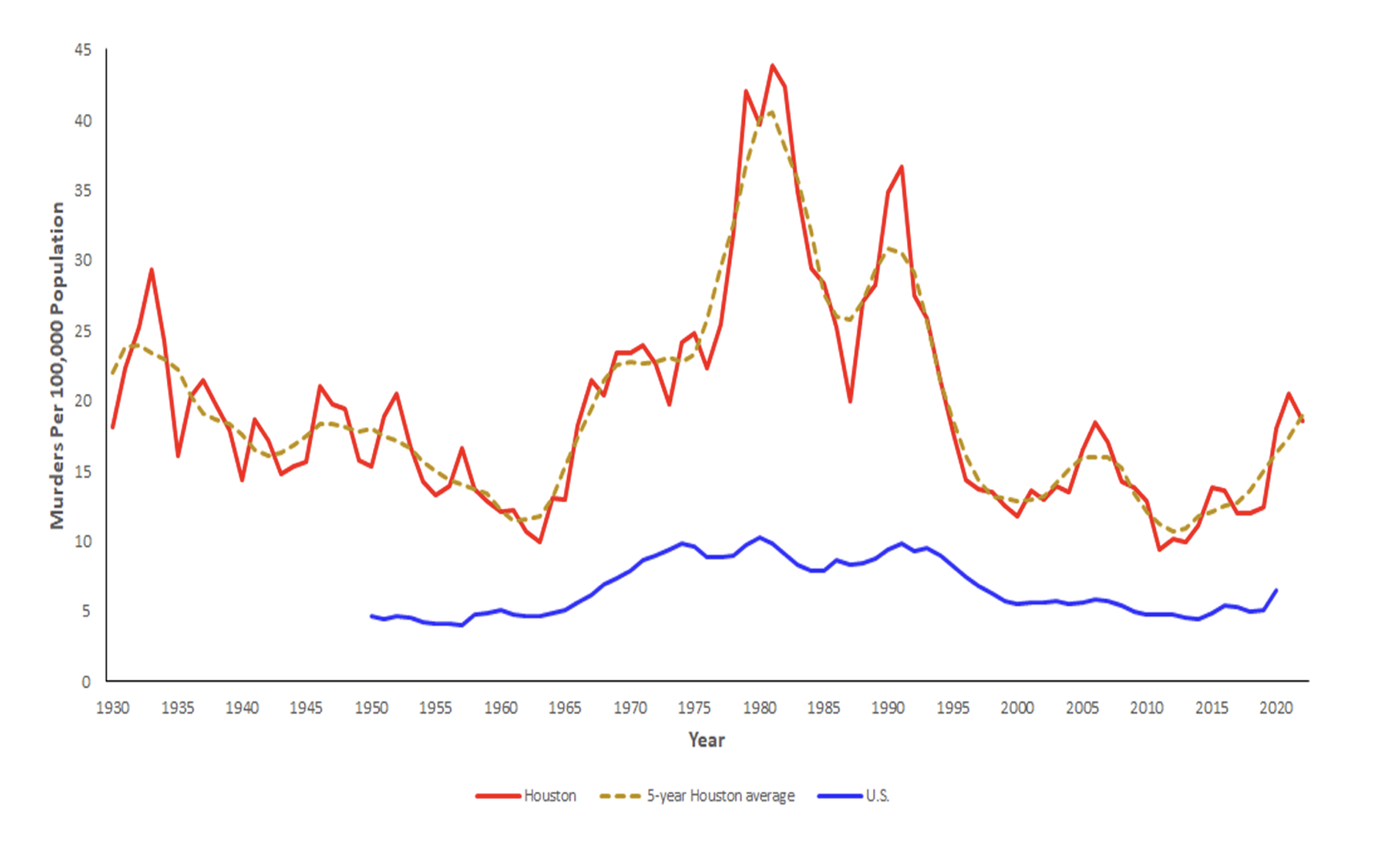
While Houston’s murder rate echoes the national trend for the overlapping years, the rate has been much higher in Houston over the entire period. In general, large cities have higher rates of murder than the national average, though there are exceptions (e.g., New York City, San Diego, San Jose, and Honolulu). Although there have been year-to-year fluctuations, there was a downward trend in the Houston murder rate from the 1930s through the early 1960s, whereupon the rate increased substantially. Though fluctuating, rates remained high until the early 1990s, when they dropped dramatically. This downward trend continued until 2011, when they started to increase again. In 2022, the murder rate dropped and has continued to drop through early 2023. Of course, we do not know whether the decrease will continue.
Although its homicide rate is still worse than the national average, Houston has become relatively safer over time, especially since the 1990s. In the 1980s, Houston had one of the highest murder rates in the country. In 1989, for example, it had the 13th-highest documented murder rate in the U.S. (Rosenfeld et al, 1992). But by 2018, it was No. 51 among cities with a population of 100,000 or more (FBI 2018).
But murders are only part of the story. Shootings that lead to injuries, many of them debilitating, are far more common than fatal shootings. Only two databases, however, provide national data on nonfatal injuries: the Wide-ranging Online Data for Epidemiologic Research (WONDER) system and the Web-based Injury Statistics Query and Reporting System (WISQARS), both run by the CDC (CDC 2023a, b). Both are individual-level databases of diseases and injuries, but they do not provide geographical detail necessary for local analysis. At the local level, there is virtually no publicly available data set for shooting injuries other than those managed by local police departments or emergency rooms. And in those cases, the data are only available by permission under strict conditions (Naik-Mathuria et al. 2021). Further, police data is spotty with respect to the number of injuries, as their extent and severity are often not known to investigating officers.
The Harris County Firearm Incident Database
We compiled a database of 53,985 firearm crimes identified through the databases of the Houston Police Department (HPD), the Harris County Sheriff’s Office (HCSO), the Baytown Police Department (BPD), and the Pasadena Police Department (PPD), the four largest law enforcement jurisdictions in Harris County. The period covered was 2018-2021. By all accounts, these four databases cover the vast majority of firearm incidents in Harris County. For example, the Harris County Medical Examiner’s Office indicated that 97% of the interpersonal firearm fatalities they investigated during 2018-2021 came from those four jurisdictions (HCIFS 2023). The database excluded firearm suicides.
Figure 2 shows a map of 53,941 geocoded incident locations. Table 1 shows the distribution of all interpersonal firearm incidents by severity.
Figure 2 — Harris County Firearm Crimes, 2018-2021 (Incident locations by police department)
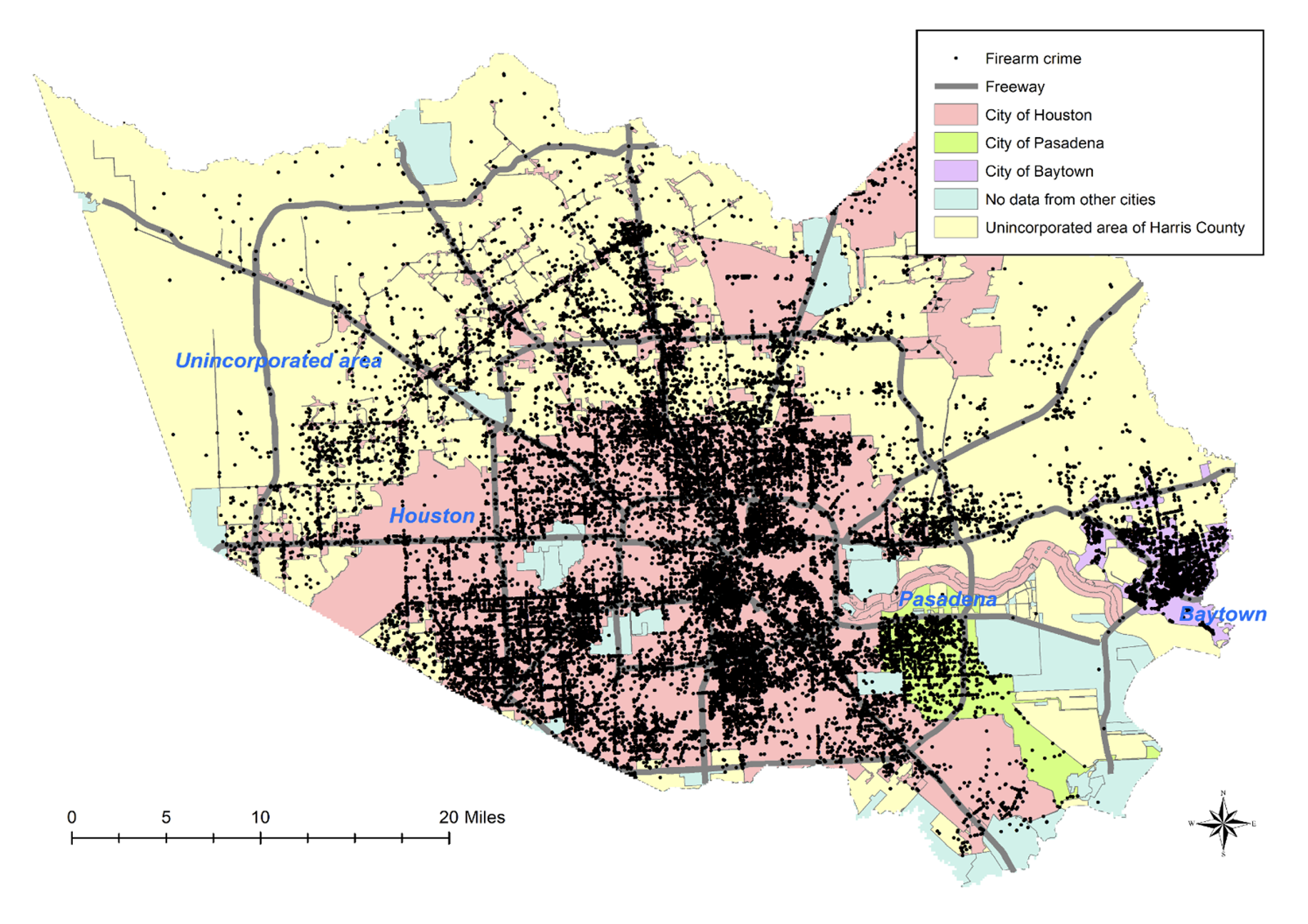
Note n = 53,941.
Table 1 — Severity of Harris County Firearm Incidents, 2018-2021
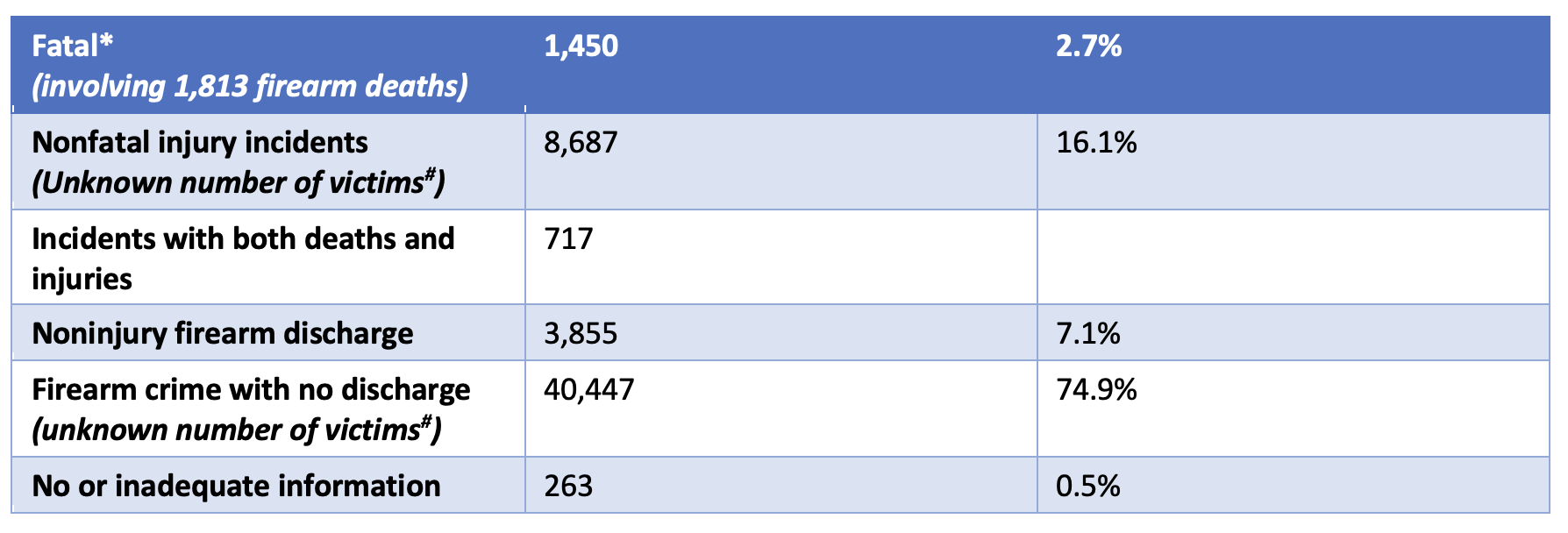
Notes * includes murder, nonnegligent manslaughter, justifiable homicide, negligent manslaughter, and unintentional/accidental deaths. # refers to the total number of individuals who may have been injured from those incidents, including those not identified by police or a hospital.
There were 1,813 interpersonal firearm fatalities in these jurisdictions over the four years occurring in 1,450 unique incidents. These included murders, justifiable homicides, manslaughter incidents, and unintentional (i.e., accidental) deaths from firearms. That is an average of 1.25 firearm fatalities per fatal incident. In addition, there were 8,687 incidents in which someone was injured by a firearm. Of these, 717 involved both fatalities and injuries.
The number of incidents involving injuries (8,687) is most likely an undercount. We do not know how many individuals were injured from those incidents. Further, we assume that there were individuals who were injured by a firearm who were not identified in the police report (e.g., they sought medical attention away from medical facilities, who are required to report firearm injuries).
Noninjury discharge crimes occur when reports of gunfire are taken by the police. These can involve serious crimes such as drive-by shootings that involve no injuries, shots being fired but with neither victims nor suspects when the police investigate, or shootings that occur during robberies without injuries. The number of noninjury discharge crimes (3,855) is probably an underestimate since not all noninjury gunshot incidents are identified.
Crimes involving firearms that were not discharged included robbery, aggravated assault, weapons violations, gun thefts, and a handful of other offenses. Guns are often used in robberies and are sometimes used as blunt instruments in assaults; in these identified cases, although a gun was not fired, a crime was committed and someone was a victim, often with injuries.
Weapons violations involved the unlawful carrying of a gun (e.g., by an ex-felon prohibited from possessing a firearm for five years after incarceration, or an individual prohibited from possessing a firearm by a court order) and the unlawful carrying of a weapon into locations where they are not allowed (e.g., airports, hospitals, bars and nightclubs, churches, amusement parks, government buildings, and private properties where they are forbidden by owners). Some police officers also categorized serious crime incidents, such as drive-by shootings or reckless behavior with a gun by individuals, as weapons violations. The distinctions between these categories are often blurred and depend on interpretation.
Of the firearm crimes documented in Harris County, 83% did not include a death or injury, although the vast majority of the incidents might have produced such outcomes. Regardless, these situations are threatening to individuals and can result in longer-term consequences. From a public health viewpoint, the number of individuals exposed to a firearm crime is much greater than the number who are injured or killed by them. Exposure to violence has been associated with many long-term adverse behavioral and mental health outcomes, even for those who are not identified in police reports as victims (Office of Disease Prevention and Health Promotion, n.d.; Beyer et al. 2015; Fowler et al. 2009).
When and Where Do Firearm Crimes Happen?
What do we know about the situations involving a firearm crime? They have a definite temporal and seasonal pattern. The monthly differences are small, but firearm crimes increase at the beginning of the year, peak in July, and then fall off in August and September. They increase again in the fall, peaking once more in December. This pattern has been found elsewhere, particularly in places with mild winters (McDowell and Curtis 2014; Cheatwood 2006). There is also a weekday pattern: Firearm crimes are slightly more likely to occur on weekend days (with an average of 15% occurring on Fridays, Saturdays, and Sundays and an average of 14% occurring on each of the other days of the week).
The biggest temporal factor, however, is nighttime. Sixty-three percent of firearm crimes occurred between 6 p.m. and 5:59 a.m., and 24% occurred after midnight. This is distinct from firearm suicides and unintentional shootings, which tend to occur in the daytime (Naik-Mathuria et al. 2023; Levine et al. 2020). As such, there is a likely relationship between firearm crimes and activities that tend to take place at night, including the use of alcohol or drugs (Levine and Ceccato 2021; Erickson et al. 2015; Jernigan et al. 2013; Grunewald 2011).
It is well documented that young males between the ages of 15 and 29 are most likely to be involved in firearm violence (e.g., Thompson and Gartner 2014; Sampson 2012; Tcherni 2011; McCall, Land, and Parker 2010; Stults 2010; Kubrin and Herting 2003). In urban areas, members of racial and ethnic minority groups (especially Black Americans) and people from low-income backgrounds are more likely to be victims of firearm homicide (Berthelot 2019; Xu et al. 2018; Beard et al. 2017). Moreover, these groups are more likely to be exposed to multiple instances of firearm violence, either directly or indirectly.
We did not have information on the victims of the Harris County shootings from the police data. But we did have information on the locations where the shootings took place, which were geographically concentrated in certain parts of the county. Figure 3 shows a kernel density interpolation of the risk of a firearm crime per 100,000 people. It is clear that the risk of firearm violence is higher in the central parts of Houston. But there are also central areas that did not show a high risk and suburban areas that did show a high risk. Further, some areas that experienced high rates of firearm violence are primarily employment centers and have small populations (e.g., the region’s two major airports, the Texas Medical Center), and their rates can be attributed primarily to low population density. However, the eastern part of the county has a particularly high firearm risk relative to its population.
Figure 3 — Harris County Firearm Risk, 2018-2021 (Interpolated)
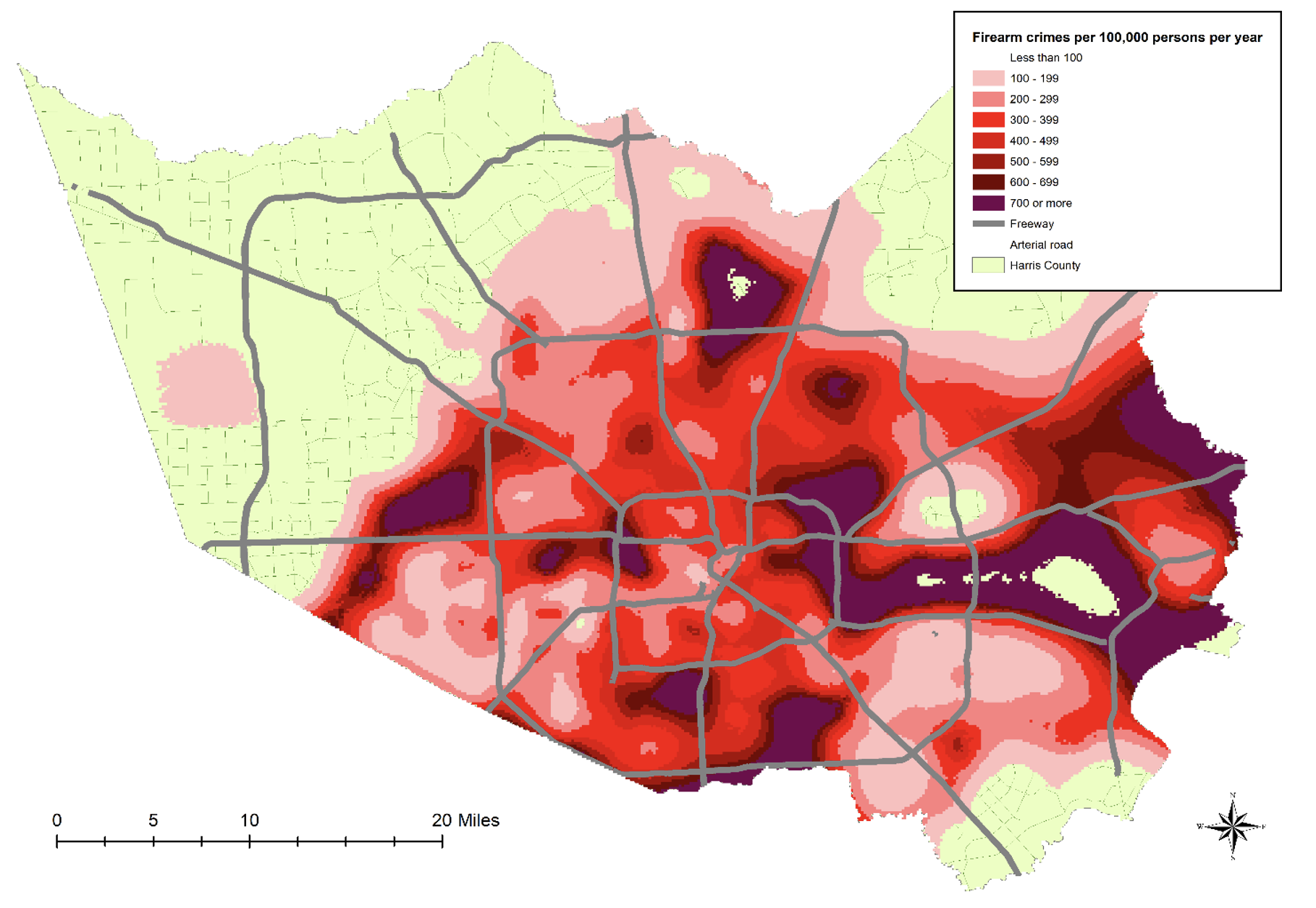
When examining the data at a more micro level, we found that firearm crimes were concentrated in relatively few areas in the county. Figures 4 and 5 show “hot spots,” or clusters, where such crimes were concentrated. These were identified using the Nearest Neighbor Hierarchical Clustering algorithm in CrimeStat (Levine 2013). The clusters are arranged hierarchically: Incidents are organized into first-order clusters, which in turn are clustered into second-order clusters. These are then organized into third-order clusters. Figure 4 shows a regional view of the clusters, while Figure 5 shows a close-in view of a firearm incident hot spot in southwest Houston.
Figure 4 — Firearm Incident Hot Spots in Harris County, 2018-2021
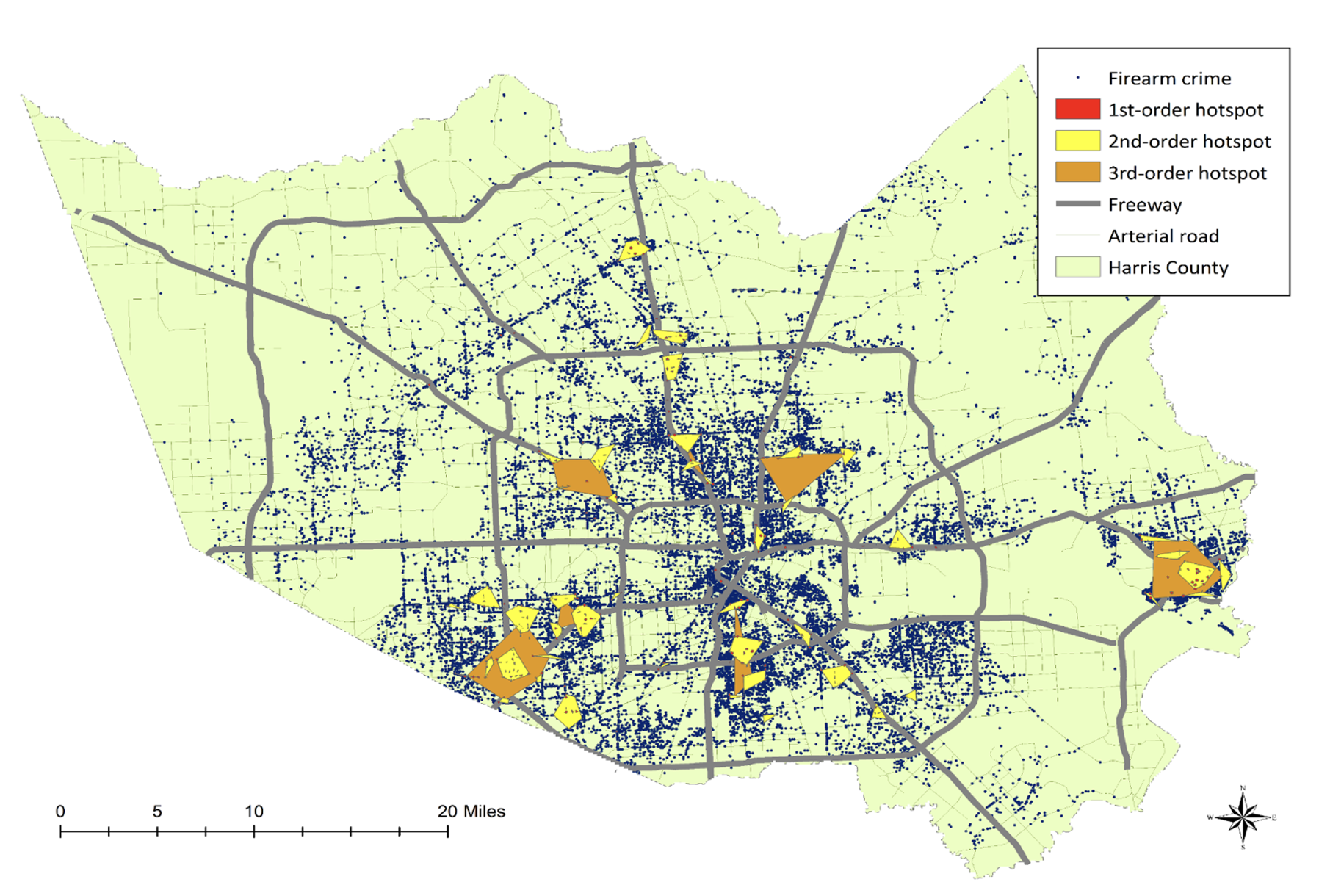
The algorithm essentially shows where firearm crimes occur near one another by specific location, neighborhood, and district. The first-order hot spots captured 29.0% of the incidents, which took place in only 0.01% of the Harris County area. The second-order clusters showed that many first-order clusters were located near each other (we call these “hot neighborhoods”). Additionally, third-order clusters show that some second-order clusters were located near each other (we call these “hot districts”). Such information could be useful to local police, who might organize patrols or other interventions focused on those areas.
Figure 5 — Close-up of Harris County Firearm Incident Hot Spot, 2018-2021
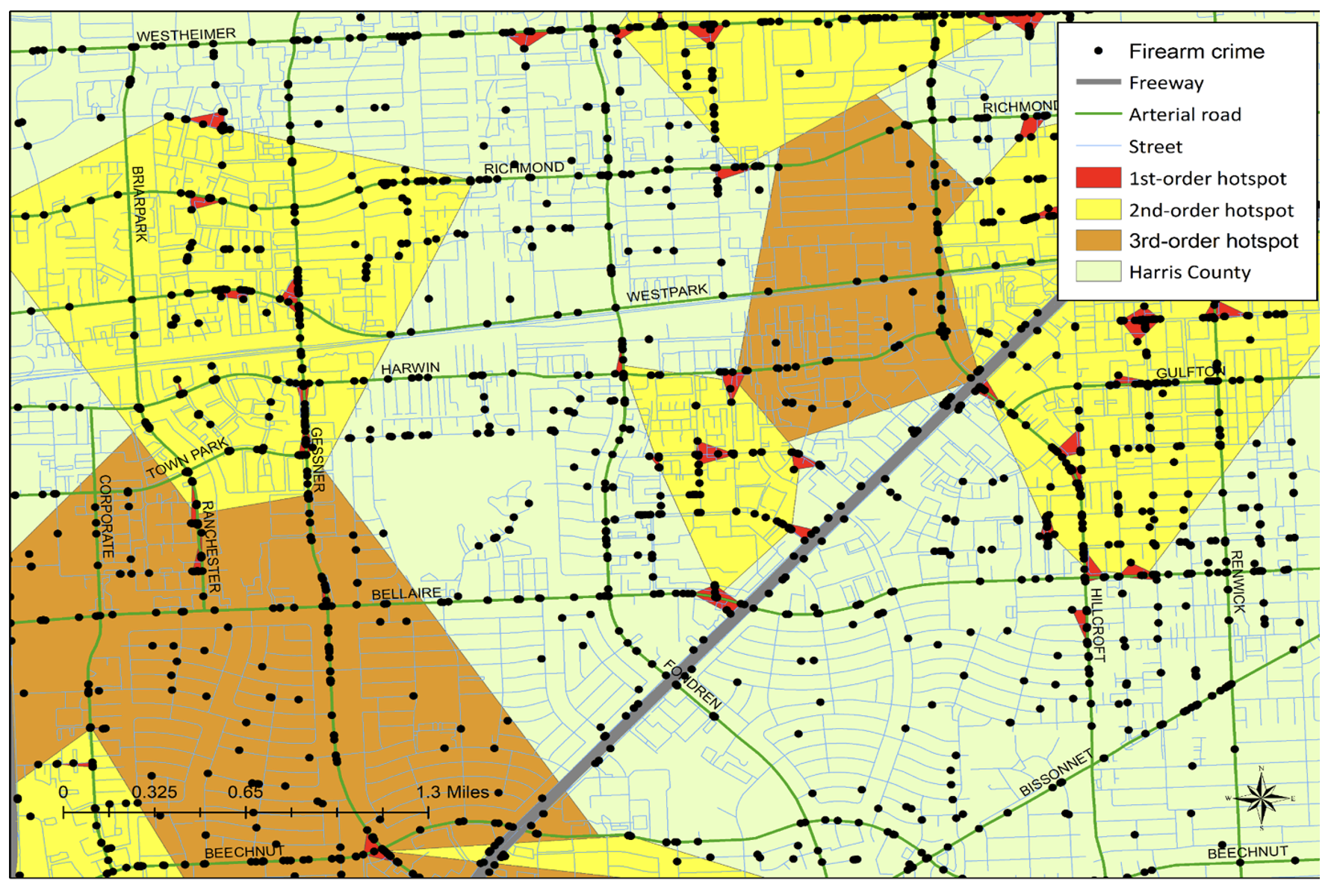
Furthermore, the data showed that gun crimes were concentrated in certain types of environments (called “premises” by police). Nearly half of the incidents were transportation-related; slightly more than one-quarter (27%) occurred on a sidewalk or adjacent to a road, and 19% occurred in a parking lot. Residential premises followed, with 12% of gun crimes occurring in single-family homes and 9% in apartments, followed by retail establishments (7%). Of the latter, convenience stores and gas stations (both 3%) were the most common premises. Further, 29% of the firearm crimes occurred within 300 feet of an alcohol-serving business.
In addition, 668 incidents occurred in an airport terminal. These were not shootings, but weapons violations. We do not have the details of the cases, but these most likely resulted from individuals taking guns into the airport terminal or even through the Transportation Security Administration passenger screening. Such events have occurred at other airports in the United States (Kim 2023; Aratani 2023).
Neighborhood Characteristics Associated with Firearm Crimes
We modeled some of the characteristics associated with hot neighborhoods by assigning the firearm incidents to census block groups (averaging roughly six square blocks in area). The characteristics that correlated with firearm crimes were those that have been documented in other studies; namely, the neighborhoods were low-income, had substantial racial and ethnic minority populations (i.e., Black Americans and Hispanics), and had higher unemployment rates. They had many vacant housing units, gas stations, and bars, and were more likely to be in industrial areas and closer to downtown Houston (though not in the downtown business district itself). Most shootings do not occur in the victims’ homes, but in nearby areas (Peterson 2022; Levine et al. 2020).
We modeled injuries and fatal shootings separately from firearm crimes with no discharge. While the spatial overlay was not identical, the same factors came up for both subsets. This points to social conditions that are conducive to firearm violence — namely poverty, lack of legitimate employment opportunities, lack of retail and service amenities, and the presence of rundown areas in need of reinvestment. Not surprisingly, what is true of violent areas in other cities is also true in Houston (e.g., Sampson 2012).
Individual Characteristics Associated With Firearm Crimes
It is important to emphasize that the vast majority of people who live in or visit a firearm crime hot spot do not commit firearm crimes, nor are they victims of firearm crimes. It is essential that the ecological relationship between neighborhood and firearm crimes is not generalized to the population. These models show where gun crimes occur, but not who the victims or perpetrators are.
Firearm violence is a rare phenomenon in a statistical sense. Even in the parts of Harris County where violence was concentrated, only a small percentage of the population experienced it (less than 10% in the areas associated with hot spots). Further, the frequency of such incidents is not regular. For example, in the hot spot with the highest number (235) of firearm crimes, incidents occurred once every six days on average. In other hot spots, they occurred less frequently.
This points to the individual factors that contribute to someone being a victim or even a perpetrator. Some of these factors are known. The association of alcohol and drugs with violence has been documented in a number of studies (Levine and Ceccato 2021; Erickson et al. 2015; Jernigan et al. 2013; Grunewald 2011; Greenfeld 1998). In addition, a history of exposure to violence in the family, being a victim of a violent crime, early aggressive behavior, low parental involvement, low emotional attachment to parents, and deficits in cognitive and social abilities have been associated with gun violence later in life, both in victims and perpetrators (CDC 2020).
In a separate study, we have analyzed the backgrounds of children and youth who have been admitted to trauma centers at major hospitals in Houston for gun injuries (Naik-Mathuria et al., forthcoming). Several of the same factors have shown up. Pediatric gunshot victims of interpersonal violence are more likely to have experienced child abuse, have a history of alcohol abuse, and have prior criminal convictions. They are also more likely to have ingested alcohol or used drugs at the time of the shooting and have been involved in confrontations with others.
More research is needed on this topic — particularly to identify early warning signs that medical personnel, teachers, and counselors who come in contact with such individuals should be aware of. Clearly, the earlier these warning signs can be identified, the more likely that an intervention can take place that redirects individuals toward less destructive paths. This is particularly true in low-income and minority neighborhoods, where repeated exposure to violence can reinforce and exacerbate problems in high-risk children.
Final Thoughts
This report does not make specific recommendations about how to address gun violence in our society. The problem is very complex, and there are very strong, polarized opinions on the topic. Until the political environment becomes less polarized, it is unlikely that we will be able to enact major policies to confront the issue.
Moreover, there is no single solution to firearm violence in the United States. The issue involves a number of exacerbating factors, including expanded gun access, lack of gun registries and gun user licensing, minimal restrictions on informal gun sales, weak child access laws, poorly regulated concealed-carry laws, problematic stand-your-ground laws, limits on authorities’ ability to keep high-risk individuals from possessing guns, few restrictions on assault rifles and high-capacity magazines, limited after-school programs for high-risk individuals, limited security protection at schools and religious organizations, risky environments that attract firearm violence, and inadequate mental health services. Actions at various levels of government and in the private sector are all needed. Further, there are so many guns around, both legal and illegal, that it seems politically impossible to reduce the number in any meaningful way. The best short-term solution may be to identify high-risk individuals and intervene in order to reduce the likelihood of their committing violence.
Interested readers should look at an examination of gun policies by researchers at the Rand Corporation who have been studying the effectiveness of gun policies that could reduce gun violence. They just released their third edition (Smart et al. 2023). Two other publications respectively evaluate the effectiveness of policies designed to keep firearms away from high-risk individuals (Webster and Wintemute 2015) and review of strategies for reducing firearm violence (NIJ 2014). Needless to say, these policies will only reduce gun violence at the margins instead of reducing the levels substantially.
We are not fatalistic about gun violence. It can be curbed. But we should start from a realistic understanding of its scope. Gun violence is ingrained in American society, and the problem will not disappear as the result of any single policy — e.g., banning assault rifles, arming school guards, or intervening with mentally ill people who have violent impulses. These policy actions may help, but a substantial reduction in gun violence will require a comprehensive approach encompassing many different programs and policies.
References
Aratani, Lori. 2023. “TSA reports increase in gun seizures at airports in D.C. region.” Washington Post, January 17, 2023. https://www.washingtonpost.com/transportation/2023/01/17/tsa-guns-seized-airports/.
Berthelot, E.R. 2019. Person or Place? A Contextual, Event History Analysis of Homicide Victimization Risk. Document 252940. Washington, D.C.: National Criminal Justice Reference Service, Office of Justice Programs, U.S. Department of Justice.
Beard, J.H., C.N. Morrison, S.F. Jacoby, B. Dong, R. Smith, C.A. Sims, and D.J. Wiebe. 2017. “Quantifying disparities in Urban Firearm Violence by Race and Place in Philadelphia, Pennsylvania: A Cartographic Study.” American Journal of Public Health Gun Control 107, no. 3 (March): 371–373.
Beyer, K., A.B. Wallis, and L.K. Hamberger. 2015. “Neighborhood Environment and Intimate Partner Violence: A Systematic Review.” Trauma, Violence & Abuse 16, no. 1: 16–47. https://doi.org/10.1177/152483801351575.
BJS. 2014. The Nation’s Two Measures of Homicide. Washington, D.C.: Bureau of Justice Statistics, Office of Justice Programs, U.S. Department of Justice.
https://bjs.ojp.gov/content/pub/pdf/ntmh.pdf.
Centers for Disease Control and Prevention. 2023a. CDC WONDER. Atlanta: Centers for Disease Control and Prevention. https://wonder.cdc.gov/.
Centers for Disease Control and Prevention. 2023b. WISQARS™ — Web-based Injury Statistics Query and Reporting System. Atlanta: Centers for Disease Control and Prevention. https://www.cdc.gov/injury/wisqars/index.html.
Centers for Disease Control and Prevention. 2020. “Risk and Protective Factors.” Atlanta: Violence Protection, Injury Center, Centers for Disease Control and Prevention. https://www.cdc.gov/violenceprevention/youthviolence/riskprotectivefactors.html.
Cheatwood, D. 2006. “Is There a Season for Homicide?” Criminology 26: 287–306.
Erickson, D.J., B.P. Carlin, K.M. Lenk, H.S. Quick, E.M. Harwood, and T.L. Toomey. 2015. “Do Neighborhood Attributes Moderate the Relationship between Alcohol Establishment Density and Crime?” Prevention Science 16, 2 (February): 254–64. https://doi.org/10.1007/s11121-013-0446-y.
FBI. 2018. “Table 8: Offenses Known to Law Enforcement by State by City 2018.” Crime in the United States: 2018. Washington, D.C.: Federal Bureau of Investigation, U.S. Department of Justice. https://ucr.fbi.gov/crime-in-the-u.s/2018/crime-in-the-u.s.-2018/tables/table-8/table-8.xls/view.
FBI. 2019. “Table 1: Crime in the United States by Volume and Rate per 100,000 Inhabitants. 2000-2019.” Crime in the United States. Washington, D.C.: Federal Bureau of Investigation, U.S. Department of Justice. https://ucr.fbi.gov/crime-in-the-u.s/2019/crime-in-the-u.s.-2019/topic-pages/tables/table-1.
Fowler, P.J., C.J. Tompsett, J.M. Braciszewski, A.J. Jacques-Tiura, and B.B. Baltes. 2009. “Community Violence: A Meta-analysis on the Effect of Exposure and Mental Health Outcomes of Children and Adolescents.” Development and Psychopathology 21, no. 1, 227–259. https://doi.org/10.1017/S0954579409000145.
Fox, J.A. and M.W. Zawitz. 2004. “Homicide Trends in the United States: 2002 Update.” Crime Data Brief. Washington, D.C.: Bureau of Justice Statistics, Office of Justice Programs, U.S. Department of Justice. https://bjs.ojp.gov/content/pub/pdf/htus02.pdf.
Gramlich, J. 2022. “What the data says about gun deaths in the U.S.” Pew Research Center, February 3, 2022. https://www.pewresearch.org/fact-tank/2022/02/03/what-the-data-says-about-gun-deaths-in-the-u-s/.
Greenfeld, L. 1998. Alcohol and Crime: An Analysis of National Data on the Prevalence of Alcohol Involvement in Crime. National Symposium on Alcohol Abuse and Crime, NCJ 168632. Washington, D.C.: Bureau of Justice Statistics, Office of Justice Programs, U.S. Department of Justice. https://bjs.ojp.gov/content/pub/pdf/ac.pdf.
Grinshteyn, E. and D. Hemenway. 2016. “Violent Death Rates: The US compared with other high-income OECD Countries, 2010.” American Journal of Medicine 129, no. 3 (March): 266–273. https://www.amjmed.com/article/S0002-9343(15)01030-X/pdf.
Gruenewald, P.J. 2011. “Regulating availability: How Access to Alcohol Affects Drinking and Problems in Youth and Adults.” Alcohol Research & Health 34, no. 2: 248–256.
Gun Violence Archive. 2023. “Gun Violence Archive 2023.” Washington, D.C.: Gun Violence Archive. https://www.gunviolencearchive.org.
HCIFS. 2023. “Private communication and data output.” Harris County Institute of Forensic Sciences, Harris County, Texas. https://ifs.harriscountytx.gov/Pages/MedicalExaminerService.aspx.
Jernigan, D. H., M. Sparks, E. Yang, and R. Schwartz. 2013.. “Using Public Health and Community Partnerships to Reduce Density of Alcohol Outlets.” Preventing Chronic Disease 10. http://www.cdc.gov/pcd/issues/2013/12_0090.htm.
Kim, Chloe. 2023. “TSA raises alarm amid increase in guns at US airports.” BBC, February 21, 2023. https://www.bbc.com/news/world-us-canada-64710509.
Kubrin, C. E., and J.R. Herting. 2003. “Neighborhood Correlates of Homicide Trends: An Analysis Using Growth-curve Modeling.” Sociological Quarterly 44: 329–350.
Levine N. 2013. “Chapter 7: Hot spot analysis of points: I.” In CrimeStat: A Spatial Statistics Program for the Analysis of Crime Incident Locations (v 4.0), edited by Ned Levine. Houston: Ned Levine & Associates and Washington, D.C.: National Institute of Justice, Office of Justice Programs, U.S. Department of Justice. http://www.nij.gov/CrimeStat.
Levine N., and V. Ceccato. 2021. “Malignant Mixes: The Overlap of Motor Vehicle Crashes and Crime in Stockholm, Sweden.” Accident Analysis & Prevention 161 (October). https://www.sciencedirect.com/science/article/pii/S0001457521003924.
Levine, N., S.A. Drake, T.F. Reynolds, Y. Yang, D.A. Wolf, D. Persse, C.E. Wade, and J.B. Holcomb. 2020. “Spatial Correlates of Firearm-related Deaths in Harris County, Texas.” Homicide Studies 25, no. 1: 37–60. https://journals.sagepub.com/eprint/ZJQNHXSXRZJDZPFZSYKE/full#.
McCall, P.L., K.C. Land, and K.F. Parker. 2010. “An Empirical Assessment of What We Know About Structural Covariates of Homicide Rates: A Return to a Classic 20 Years Later.” Homicide Studies 14: 219–243.
McDowall, D., and K. Curtis. 2014. “Seasonal Variation in Homicide and Assault Across Large U.S. Cities.” Homicide Studies 19.
Naik-Mathuria, B., N. Levine, C. Cain, A.O. Oluyomi, M. Henson-Garcia, and L. Pompeii. Forthcoming. “Characteristics of Pediatric Firearm Injuries.”
Naik-Mathuria, B., N. Levine, C. Cain, A.O. Oluyomi, M. Henson-Garcia, and L. Pompeii. 2021. “Comprehensive Local Injury Surveillance for Pediatric Fatal and Nonfatal Firearm Injury Prevention Planning.” Journal of Applied Research on Children: Informing Policy for Children at Risk 12, no. 4. https://digitalcommons.library.tmc.edu/cgi/viewcontent.cgi?article=1495&context=childrenatrisk.
NIJ (2014). “Practice profile: Reducing gun violence.” Crime Solutions, National Institute of Justice, Office of Justice Programs, U.S. Department of Justice. https://crimesolutions.ojp.gov/ratedpractices/33
Office of Disease Prevention and Health Promotion. (n.d.). “Social determinants of health.” U.S. Department of Health and Human Services. https://health.gov/healthypeople/objectives-and-data/social-determinants-health.
Peterson. 2022. Public Mass Shootings: Database Amasses Details of a Half Century of U.S. Mass Shootings with Firearms, Generating Psychosocial Histories. Washington, D.C.: National Institute of Justice, Office of Justice Programs, U.S. Department of Justice. https://nij.ojp.gov/topics/articles/public-mass-shootings-database-amasses-details-half-century-us-mass-shootings.
Rosenfeld, R., Decker, S., and Kohfield, C. (1992). "Different Levels, Common Causes: St. Louis Homicide Rates in National Perspective”. In Block, C. R., & Block, R. L. (Eds.), Questions and Answers in Lethal and Non-lethal Violence: Proceedings of the First Annual Workshop of the Homicide Research Working Group. June 14-16, 1992. Ann Arbor, MI. US Department of Justice, Office of Justice Programs, National Institute of Justice; 1992. 3-10. https://www.ojp.gov/ncjrs/virtual-library/abstracts/questions-and-answers-lethal-and-non-lethal-violence-proceedings.
Smart, R., A.R. Morral, R. Ramchand, A. Charbonneau, J. Williams, S. Smucker, S. Cherney, and L. Xenakis. 2023. The Science of Gun Policy: A Critical Synthesis of Research Evidence on the Effects of Gun Policies in the United States. Santa Monica: Gun Policy Initiative, RAND Corporation. https://www.rand.org/pubs/research_reports/RRA243-4.html.
Sampson, R. J. 2012. Great American City: Chicago and the Enduring Neighborhood Effect. Chicago: University of Chicago Press.
Stults, B.J. 2010. “Determinants of Chicago neighborhood homicide trajectories: 1965–1995.” Homicide Studies 14: 244–267.
Tcherni, M. 2011. “Structural Determinants of Homicide: The Big Three.” Journal of Quantitative Criminology 27: 475–496.
Thompson, S.K. and R. Gartner. 2014. “The Spatial Distribution and Social Context of Homicide in Toronto's Neighborhoods.” Journal of Research in Crime and Delinquency 51: 88–188.
Webster, D.W., and G.J. Wintemute. 2015. “Effects of Policies Designed to Keep Firearms from High-risk Individuals.” Annual Review of Public Health 36: 2–37. https://www.annualreviews.org/doi/pdf/10.1146/annurev-publhealth-031914-122516.
Xu, J., S.L. Murphy, K.D. Kochanek, B. Bastian, and E. Arias. 2018. “Deaths: Final Data for 2016.” National Vital Statistics Report 67, no. 5: 1–76. https://www.cdc.gov/nchs/data/nvsr/nvsr67/nvsr67_05.pdf.
The authors want to thank these agencies and people for providing data: Melissa Cummins of the Houston Police Department, Demetrius Snow of the Harris County Sheriff’s Office, Melisa Bajirami of the Pasadena Police Department; Timothy Carter of the Baytown Police Department; and Michel Pierce and Dr. Dwayne Wolf of the Harris County Medical Examiner’s Office. We also want to thank Dr. Richard Block, professor emeritus at Loyola University Chicago and Barry Fosberg of the Houston Police Department for their helpful comments on the paper.
This material may be quoted or reproduced without prior permission, provided appropriate credit is given to the author and Rice University’s Baker Institute for Public Policy. The views expressed herein are those of the individual author(s), and do not necessarily represent the views of Rice University’s Baker Institute for Public Policy.


